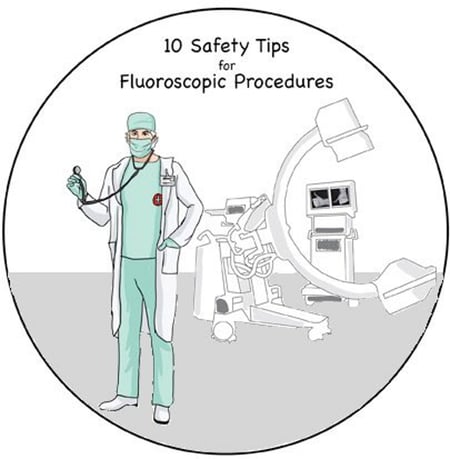Your patients need accurate and specific needle placement for an interventional pain procedure—and the best way to do so is with fluoroscopy. However, that means you, your patient and other personnel will be exposed to radiation. So how do you reduce the risks?

It is a good and very important question.
Fortunately, there are techniques that can reduce the risk for all concerned. And there are federal regulations in place to limit the maximum output for C-Arms.
Here are 10 important considerations and safety tips for fluoroscopic procedures.
- Talk to your patient about the radiation risks. They need to be informed about and understand that the radiation dose may be high, and what the risks are, including damage to DNA. It’s important to share this information in a way that is easy to understand. Remember, much of the terminology and language that you use day in and day out is foreign to them.
- Try to reduce the amount of radiation exposure. Obviously, you can’t shield your patients entirely. However, you can reduce their exposure to radiation by limiting or adjusting the time of exposure to radiation.
- Adjust distance. Your patient’s exposure to radiation increases exponentially by how close the patient is to the x-ray tube. Try to position your patient as far as possible from the tube. Ideally, your patient should be 12-15 inches away. In addition, your patient should be as close as possible to the image intensifier.
- Shorten the fluoro times. If you use intermittent fluoroscopy in combination with the image hold capacity, you can reduce the amount of radiation. You can also use pulsed fluro, single pulse, manual mode, image hold and the timer warning settings.
- Unauthorized personnel should not be in the room during the fluoroscopy. Only the personnel trained and required for the procedure should be in attendance.
- Analyze original radiographs before performing the fluoroscopic examination. This can reduce the repeat rate for the time required for the procedure.
- Stand on the image intensifier side of the C-Arm when performing the procedure. This will avoid radiation leakage from the x-ray tube.
- Be sure to step away from the patient during the fluoroscopy. Placing yourself one foot further (or more) from the patient will reduce the amount of radiation you are exposed to.
- Shield yourself as much as possible. Leaded eyewear with side shields can protect the lens or your eyes. Without side shields, your eyes are not protected if you look sideways from the C-Arm x-ray tube to see the image on the monitor. You should also wear leaded gloves and wear a wrap-around apron which will keep the lead between you and the x-ray tube.
- Install structural shielding to reduce radiation. This could be a lead acrylic shield that is under the table or even mounted on the ceiling.
If you have questions or ideas to share, contact one of the experts at Atlantis Worldwide. We’re here to support the industry, and provide refurbished C-Arms and used medical imaging equipment that suits your needs, budget and demands.
Contact Us Today!
Some blogs you may have missed:
- 4 Tips On Maintenance & Service for Your Medical Imaging Equipment
- OEC Brivo Plus C-Arm, OEC 9800 or OEC 9900: Which is Right for You?
- How Much Does it Cost to Lease a C-Arm?
- Hands, Shoulders, Knees and Toes: A Love Affair with the Mini C-Arm
- 15 Great Comparisons: Imaging Equipment: C-Arms, CT, Mammo…
Meet the author: Alex Silbergleit



